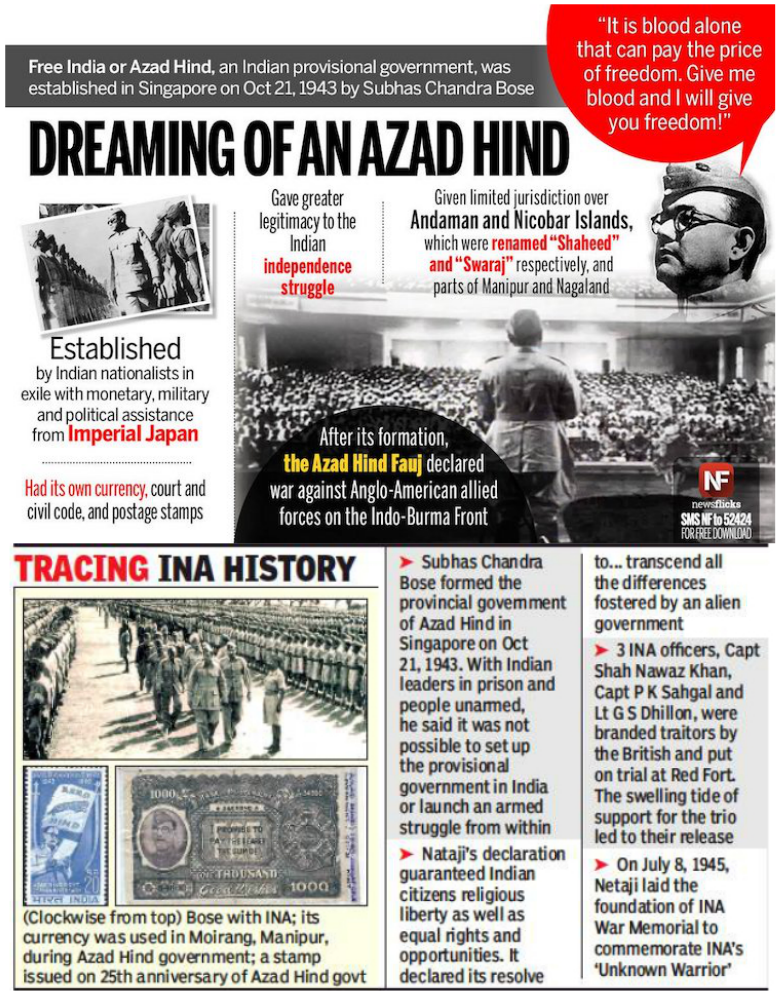

- Prime Minister, Shri Narendra Modi recently hoisted the National Flag at Red Fort, to commemorate the 75th Anniversary of formation of Azad Hind Government, formed by Netaji Subhas Chandra Bose.
- Speaking on the occasion, PM said that Azad Hind government represented the vision laid down by Subhas Chandra Bose, of a strong undivided India.
Context
- Prime Minister, Shri Narendra Modi recently hoisted the National Flag at Red Fort, to commemorate the 75th Anniversary of formation of Azad Hind Government, formed by Netaji Subhas Chandra Bose.
- Speaking on the occasion, PM said that Azad Hind government represented the vision laid down by Subhas Chandra Bose, of a strong undivided India.
About
- The Azad Hind Government, founded on 21st October, 1943 in occupied Singapore, was inspired by Netaji Subhash Chandra Bose who was the leader of Azad Hind Government and also the Head of State of this Provisional Indian Government-in-exile. Revolutionary leader Rash Behari Bose was designated as the supreme advisor.
- It supported by the Empire of Japan, Nazi Germany, Italian Social Republic, and their allies.
- The government proclaimed authority over Indian civilian and military personnel in Southeast Asian British colonial territory and prospective authority over Indian territory to fall to the Japanese forces and the Indian National Army during the Japanese thrust towards India during the Second World War.
- However, while it possessed all the nominal requisites of a legitimate government, it lacked large and definite areas of sovereign territory until Japan gave it nominal authority of the Andaman and Nicobar Islands in 1943 and the occupation of parts of Manipur and Nagaland.
- Japanese officials made all the decisions, and throughout its existence it was entirely dependent on Japanese support. The islands were re-occupied by the British in 1945.
- Immediately after the formation of the government-in-exile, Azad Hind declared war against the Anglo-American allied forces on the Indo-Burma Front. Its army, the "Azad Hind Fauj" (Indian National Army or the INA), fought against the British Indian Army and the allied forces as part of the Imperial Japanese Army in the Imphal-Kohima sector.
- Bose’s death was seen as the end to the Azad Hind movement. The Second World War also ended in 1945 with the defeat of the Axis powers.
Significance
- Netaji Subhas Chandra Bose was convinced that armed struggle was the only way to achieve independence for India. The role of Azad Hind Fauj or the Indian National Army (INA) had been crucial in leaving behind a much needed impetus to India’s struggle for Independence.
- Azad Hind government wasactively involved in nation building and had even started its own bank, currency, civil code and stamps.
- According to experts, Netaji laid down the foundation for equal opportunity for women in armed forces, through the formation of Rani Jhansi Regiment. Prime Minister in his address said that the government is carrying forward this legacy in true means and reiterated that women will be given equal opportunity for permanent commission in armed forces.
- The existence of the Azad Hind Government gave a greater legitimacy to the independence struggle against the British.
Learning Aid




